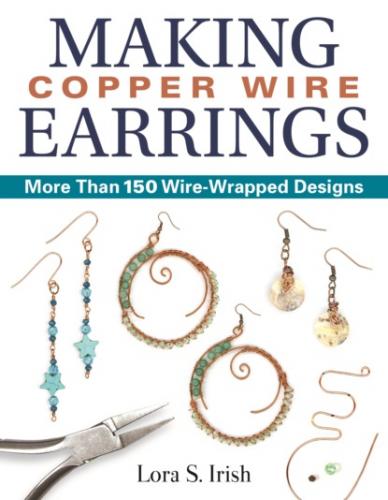CHAPTER 1
Materials and Tools
Wire, of course, is the main material needed for any wire-wrapped earring project. For the projects and samples in this book, I have used copper wire as the main link wire. A few essential tools are needed to create wirework links and to add wire-wrapped accents. A basic toolkit will include wire cutters, chain-nose pliers, round-nose pliers, nylon-jaw pliers, and some kind of file; there are also a lot of additional specialty tools that can come in handy. In addition, a variety of beads can add colorful accents to wire-wrapped earrings. With this collection of basic items, you will be able to make amazing creations. Read on for all the nitty-gritty details about wire, tools, and beads.
WIRE
Jewelry wire comes in a variety of metals and coated metals, such as gold-filled, gold-plated, sterling silver, silver-plated, brass, colored copper, copper, and color-coated aluminum.
Wire is measured by gauge; the higher the gauge, the thinner the diameter of the wire. For making links, use thick gauges from 12 (very thick) to 18 (less thick). Wrapping wires are normally worked using thinner gauges, from 20 (thin) to 26 (very thin).
Copper wire is a favorite for modern wirework jewelry and wire-wrapped jewelry. Available in round, half-round, and square, it is easy to bend and form into almost any shape. It’s also great for the beginner and intermediate jewelry crafter because it is inexpensive and available in a wide range of color coatings. Throughout this book, we will be using copper wire; however, any technique taught in this book can be worked with any metal wire.
Wire comes in three hardness levels; from hardest to softest, these are full-hard, half-hard, and dead-soft. Dead-soft is what you’ll want to use for most of the projects in this book; you can manipulate it a lot before it becomes work-hardened (a term meaning stiffening that occurs during manipulation) and therefore difficult to further manipulate. Half-hard wire can be used for earring hooks or simpler wirework link shapes that won’t require too much manipulation. Avoid full-hard wire for the projects in this book.
WIRE GAUGE
Wire thickness is measured in gauge, with smaller numbers denoting thicker wire. In this image, copper wires of four different gauges were wrapped around a 1 ¼" (3cm)–wide medicine bottle to create identically sized hoop links. From top to bottom, the gauges used are 14, 16, 18, and 20. All four hoop links are wrapped using 28-gauge wire.
While any link can be created from wire of any gauge, in general, for the projects in this book, 18- and 20-gauge wire is used as the main earring link wire, as these gauges are strong enough to hold their shape but light enough to work as earrings. 20-, 24-, and 26-gauge wire is used throughout the projects for the wire-wrapping steps, as thinner wire is more flexible when woven through the bends of the links.
Equivalents
Most jewelry wire is packaged and sold with a US gauge size and a UK millimeter size, but just in case you’re in the UK and don’t have the US gauge, here is a quick reference chart of US gauge and its equivalent millimeter size.
| Gauge | Millimeters |
| 12 | 2mm |
| 14 | 1.6mm |
| 16 | 1.3mm |
| 18 | 1mm |
| 20 | 0.8mm |
| 22 | 0.6mm |
| 24 | 0.5mm |
| 26 | 0.4mm |
| 28 | 0.3mm |
| 30 | 0.25mm |
| 32 | 0.2mm |
From top to bottom, the wire gauges used for these hoops are 14, 16, 18, and 20.
The contrast of wire gauges is very obvious in this set, which uses 18-gauge and 30-gauge wire.
RECOMMENDED TYPES OF WIRE
While you can, of course, buy wire through jewelry supply stores and craft stores, copper, brass, aluminum, and stainless steel wire are also commonly available at your local hardware store or from online hardware suppliers. You can also purchase large quantities of wire (in 1-pound spools) online through marketplaces such as Amazon and eBay. All four of these types of wire make wonderful earrings while remaining inexpensive enough that you can freely practice, experiment, and play before moving on to work with more expensive wire like silver or gold wire.
Copper wire is considered a soft wire and can easily be bent using just the pressure of your fingers. After the link is created, it can be work-hardened by lightly tapping the link for about one minute with a nylon mallet.
Brass wire is very hard and needs even, strong pressure to create smooth bends. Brass does not tarnish and retains its bright yellow tone for years.
Aluminum wire is available in a range of hardnesses, from very soft craft wire to harder hardware wire.
Stainless steel wire is a hard wire that can be bent using jewelry tools and a little extra pressure. The metal does not tarnish over time, retaining its bright appearance.
TOOLS
WIRE CUTTERS
Several kinds of wire cutters can serve different purposes. If you only have a budget for one wire cutter, make it a flush cutter.
1 The inner face of a flush cutter is V-shaped to create a sharp cutting edge. The outer face is flush, which leaves a flat, smooth cut on the end of the wire. Plus, the fine tips of a flush cutter allow you to reach into tight
